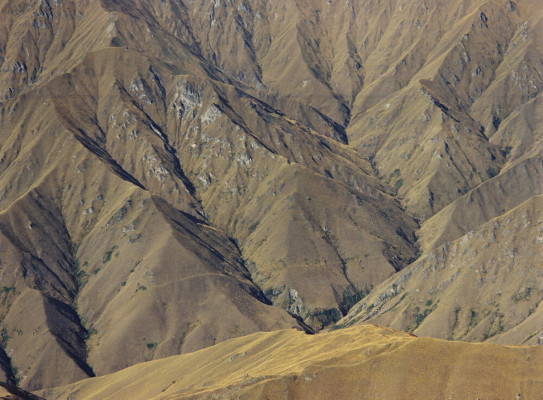
Alpine Fault magnitude 8 (AF8)

This external programme is a collaborative effort to save lives after a severe earthquake on the Alpine Fault by planning and preparing a coordinated response across the South Island.
Overview
Alpine Fault Magnitude 8 (AF8) is a collaboration between an interdisciplinary team of researchers and is led and managed by the six South Island Civil Defence Emergency Management (CDEM) groups. The research team hails from six universities and Crown Research Institutes, emergency services, lifelines, iwi, health authorities and many other partner agencies. The programme is managed by Emergency Management Southland and Marlborough and is currently funded through the Natural Hazards Commission Toka Tū Ake. GNS Science contributes to and support this programme, along with several other programmes dedicated to researching the Alpine Fault.
The programme aims to
- build collective resilience and preparedness to the next Alpine Fault earthquake event
- increase awareness, enable conversation and build societal preparedness to natural hazard events in the South Island in general
To achieve these objectives, the programme leverages
- scientific modelling
- response planning
- community engagement
The project
The Alpine Fault
The Alpine Fault runs for about 600km up the spine of the South Island. It’s the "on-land" boundary of the Pacific and Australian Plates. This fault has ruptured four times in the past 1,100 years, each time producing an earthquake of about magnitude MW 8.
The Alpine Fault has a 75% chance of rupturing in the next 50 years. The rupture will produce one of the biggest earthquakes since European settlement of New Zealand, and it will have a major impact on the lives of many people. AF8 is a research and civil defence programme dedicated to preparing communities for an Alpine Fault rupture. GNS contributes knowledge and personnel to support AF8’s research activities.
AF8 - What Is The Alpine Fault – This AF8 video takes you through some of the science and history of the Alpine Fault, so that you can be better prepared for the next rupture. transcript
This is the Alpine Fault and it's where the Pacific plate and the Australian plate meet.
A fault is a break in the Earth's crust where one side of the fault is moving relative to the other but it happens in a short sharp movement during an earthquake. So this light green rock is the Pacific plate and it's been dragged up from depth over many millions of years and sitting on top of the Australian plate so this is the Alpine Fault an active tectonic plate boundary right before our very eyes.
The Alpine Fault is an 800 kilometer long structure and it carves its way right down the western side of the Southern Alps in the South Island of New Zealand and the Alpine Fault is of concern to us because it has the potential to release a magnitude 8 earthquake sometime in the next few years. But the paleo seismic evidence on the Alpine Fault tells us that over the last eight thousand years there have been 26 magnitude 8 earthquakes.
Those events have happened incredibly regularly through time, so given that the Alpine Fault has a long history of
generating these big earthquakes, it's highly likely that we'll have another one within our lifetime.
During an Alpine Fault earthquake we'd expect horizontal movement of about 8 or 9 meters and vertical uplift of 2 or 3 metres.
The Alpine Fault is a very long fault and when there's an Alpine Fault rupture it's going to break the surface right along that length so we're expecting a 400 kilometer rupture of the Alpine Fault. Now where you get surface rupture is where the most damage is done, so if there's a road a bridge or a community living across the Alpine Fault itself it's going to be really badly affected.
It's going to have a very broad impact across the South Island, our highway network, our power, communications, all of our critical infrastructure will be really badly affected by the Alpine Fault event. When we have an Alpine Fault earthquake it's really important that people are prepared beforehand because the more prepared you can be, the more comfortable your life is going to be afterwards. So we all have a part to play in earthquake preparedness
AF8 - What Is The Alpine Fault
This AF8 video takes you through some of the science and history of the Alpine Fault, so that you can be better prepared for the next rupture.
The work done by AF8
The first research activities conducted by the programme were to model the most credible scenario for a rupture on the Alpine Fault. Starting in 2016, researchers reviewed what was already known about the Alpine Fault and developed a scenario for the next significant earthquake and the foreseeable impacts.
This scenario formed the basis of planning for a coordinated response in the week immediately following the next rupture. In a series of planning workshops, the Alpine Fault earthquake scenario was presented to each of the six Civil Defence Emergency Management (CDEM) Groups and their partner agencies. These workshops facilitated local discussions about the practicalities and challenges of responding to a significant earthquake.
The outcomes of these meetings were used to develop the South Island Alpine Fault Earthquake Response [SAFER] Framework. Launched in October 2018, the framework enables each CDEM Group and partner agency to focus on detailed preparation and planning. That means engaging communities, iwi, lifelines agencies, emergency services, businesses among others to plan and prepare for a severe earthquake on the Alpine Fault. The result will be a coordinated, mutually supportive, sustainable response across the South Island, to minimise loss of life and provide for the immediate and short-term needs of our affected communities.
AF8 today
Today, AF8 is focused on activities that build our collective resilience. There is an ongoing programme of research, planning, preparedness and activity. Recent activities include developing the richest record yet of the Alpine Fault’s history, which yielded a pattern that helps improve the reliability of forecasting what’s to come. The programme continues to share the Alpine Fault hazard and impact science and preparedness information widely, through outreach and engagement activities, to increase awareness, enable conversation and build societal preparedness to natural hazard events in the South Island.
-
Publications
Recent key publications
Howarth, J.D., Barth, N.C., Fitzsimons, S.J. et al. Spatiotemporal clustering of great earthquakes on a transform fault controlled by geometry. Nat. Geosci. 14, 314–320 (2021). https://doi.org/10.1038/s41561-021-00721-4(external link)
Orchiston, C., Mitchell, J., Wilson, T., Langridge, R., Davies, T., Bradley, B., Johnston, D., Davies, A., Becker, J., Mckay, A. 2018. Project AF8: developing a coordinated, multi-agency response plan for a future great Alpine Fault earthquake. New Zealand Journal of Geology and Geophysics 61 (3): 389-402. doi: 10.1080/00288306.2018.1455716

Research project details
Collaborators: University of Canterbury, University of Otago, GNS Science, six South Island Civil Defence Emergency Management (CDEM) groups, research from six universities and Crown Research Institutes, emergency services, lifelines, iwi, health authorities and many other partner agencies.
Duration
2016 – present
Funding platform
Ministry of Civil Defence Emergency Management Resilience Fund
Status
Current
Programme leader
Dr Caroline Orchiston
Funder
Ministry of Civil Defence & Emergency Management (MCDEM); Resilience to Nature’s Challenges; the Natural Hazards Commission Toka Tū Ake.